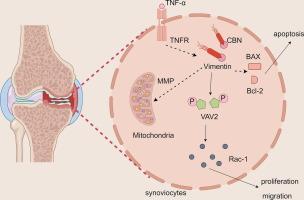当前位置:
X-MOL 学术
›
J. Adv. Res.
›
论文详情
Our official English website, www.x-mol.net, welcomes your
feedback! (Note: you will need to create a separate account there.)
Columbianadin ameliorates rheumatoid arthritis by attenuating synoviocyte hyperplasia through targeted vimentin to inhibit the VAV2/Rac-1 signaling pathway
Journal of Advanced Research ( IF 11.4 ) Pub Date : 2024-10-05 , DOI: 10.1016/j.jare.2024.09.030 Yuli Han, Changqing Liu, Shujing Chen, Huihui Sun, Zhaoyu Jia, Jiaxin Shi, Lirong Wang, Kunze Du, Yanxu Chang
中文翻译:

Columbianadin 通过靶向波形蛋白减轻滑膜细胞增生以抑制 VAV2/Rac-1 信号通路,从而改善类风湿性关节炎
类风湿性关节炎 (RA) 是一种以滑膜炎症为病理特征的自身免疫性疾病。滑膜细胞的异常激活似乎伴随着 RA 的进展。天然香豆素 columbianadin (CBN) 在 RA 中的作用和确切分子机制尚不清楚。
本研究旨在探讨波形蛋白对 RA 滑膜细胞异常生长特性的影响以及 CBN 的靶向调节作用。
使用伤口愈合和 transwell 方法检测细胞迁移和侵袭。从机制上讲,通过基于活性的蛋白质分析筛选和鉴定 CBN 的直接分子靶标。Western blotting 和 qRT-PCR 检测细胞和小鼠滑膜中相关蛋白和 mRNA 的表达。记录小鼠爪肿胀程度和体重的变化。采用 H&E 染色、甲苯胺蓝染色和 micro-CT 可视化小鼠踝关节的病理损伤程度。使用波形蛋白的小干扰 RNA 和质粒过表达来观察它们对 MH7A 细胞增殖、迁移、细胞凋亡和下游分子信号传导的影响。
TNF α诱导的 MH7A 细胞增殖和迁移可被 CBN (25,50 μM) 显着抑制,并且可以调节细胞凋亡和自噬相关蛋白的表达。此外,CBN 可以直接与波形蛋白结合并抑制其在滑膜细胞中的表达和功能,从而改善 CIA 小鼠的足部和爪部肿胀和关节损伤。波形蛋白的沉默和过表达可能通过激活 VAV2 磷酸化介导的 Rac-1 表达参与 RA 滑膜增生和侵袭性软骨的发生,这会影响异常生长特性,例如滑膜细胞侵袭和迁移。
CBN 靶向波形蛋白抑制 RA 滑膜细胞的过度激活,从而延缓 CIA 小鼠的病理过程,这为理解 RA 滑膜增生的病理机制提供了有价值的靶点和见解。
更新日期:2024-10-05
Journal of Advanced Research ( IF 11.4 ) Pub Date : 2024-10-05 , DOI: 10.1016/j.jare.2024.09.030 Yuli Han, Changqing Liu, Shujing Chen, Huihui Sun, Zhaoyu Jia, Jiaxin Shi, Lirong Wang, Kunze Du, Yanxu Chang

|
Introduction
Rheumatoid arthritis (RA) is an autoimmune disease pathologically characterized by synovial inflammation. The abnormal activation of synoviocytes seems to accompany the progression of RA. The role and exact molecular mechanism in RA of columbianadin (CBN) which is a natural coumarin is still unclear.Objectives
The present research aimed to investigate the effect of vimentin on the abnormal growth characteristics of RA synoviocytes and the targeted regulatory role of CBN.Methods
Cell migration and invasion were detected using the wound healing and transwell method. Mechanistically, the direct molecular targets of CBN were screened and identified by activity-based protein profiling. The expression of relevant proteins and mRNA in cells and mouse synovium was detected by western blotting and qRT-PCR. Changes in the degree of paw swelling and body weight of mice were recorded. H&E staining, toluidine blue staining, and micro-CT were used to visualize the degree of pathological damage in the ankle joints of mice. Small interfering RNA and plasmid overexpression of vimentin were used to observe their effects on MH7A cell proliferation, migration, apoptosis, and downstream molecular signaling.Results
The TNF-α-induced proliferation and migration of MH7A cells could be significantly repressed by CBN (25,50 μM), and the expression of apoptosis and autophagy-associated proteins could be modulated. Furthermore, CBN could directly bind to vimentin and inhibit its expression and function in synoviocytes, thereby ameliorating foot and paw swelling and joint damage in CIA mice. Silencing and overexpression of vimentin might be involved in developing RA synovial hyperplasia and invasive cartilage by activating VAV2 phosphorylation-mediated expression of Rac-1, which affects abnormal growth characteristics, such as synoviocyte invasion and migration.Conclusion
CBN-targeted vimentin restrains the overactivation of RA synoviocytes thereby delaying the pathological process in CIA mice, which provides valuable targets and insights for understanding the pathological mechanisms of RA synovial hyperplasia.中文翻译:

Columbianadin 通过靶向波形蛋白减轻滑膜细胞增生以抑制 VAV2/Rac-1 信号通路,从而改善类风湿性关节炎
介绍
类风湿性关节炎 (RA) 是一种以滑膜炎症为病理特征的自身免疫性疾病。滑膜细胞的异常激活似乎伴随着 RA 的进展。天然香豆素 columbianadin (CBN) 在 RA 中的作用和确切分子机制尚不清楚。
目标
本研究旨在探讨波形蛋白对 RA 滑膜细胞异常生长特性的影响以及 CBN 的靶向调节作用。
方法
使用伤口愈合和 transwell 方法检测细胞迁移和侵袭。从机制上讲,通过基于活性的蛋白质分析筛选和鉴定 CBN 的直接分子靶标。Western blotting 和 qRT-PCR 检测细胞和小鼠滑膜中相关蛋白和 mRNA 的表达。记录小鼠爪肿胀程度和体重的变化。采用 H&E 染色、甲苯胺蓝染色和 micro-CT 可视化小鼠踝关节的病理损伤程度。使用波形蛋白的小干扰 RNA 和质粒过表达来观察它们对 MH7A 细胞增殖、迁移、细胞凋亡和下游分子信号传导的影响。
结果
TNF α诱导的 MH7A 细胞增殖和迁移可被 CBN (25,50 μM) 显着抑制,并且可以调节细胞凋亡和自噬相关蛋白的表达。此外,CBN 可以直接与波形蛋白结合并抑制其在滑膜细胞中的表达和功能,从而改善 CIA 小鼠的足部和爪部肿胀和关节损伤。波形蛋白的沉默和过表达可能通过激活 VAV2 磷酸化介导的 Rac-1 表达参与 RA 滑膜增生和侵袭性软骨的发生,这会影响异常生长特性,例如滑膜细胞侵袭和迁移。
结论
CBN 靶向波形蛋白抑制 RA 滑膜细胞的过度激活,从而延缓 CIA 小鼠的病理过程,这为理解 RA 滑膜增生的病理机制提供了有价值的靶点和见解。


















































 京公网安备 11010802027423号
京公网安备 11010802027423号